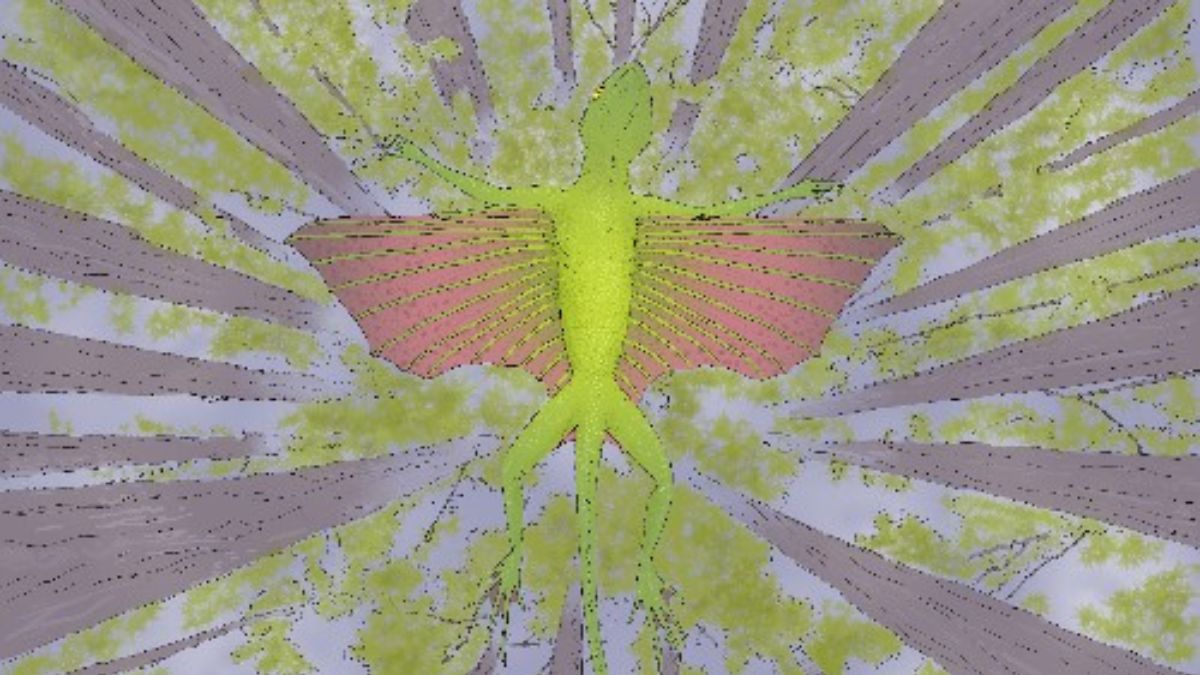Flying crocodile: A student has discovered fossils of a 200-million-year-old flying crocodile genus in Somerset, England. Known as Kuehneosaurs, these gliding winged-reptiles were closely related to the ancestors of crocodilians and dinosaurs, and had an appearance similar to that of lizards. Kuehneosaurus is an extinct genus of reptiles from the Late Triassic period, which lasted between 237 million years ago and 201.4 million years ago.
The study describing the findings was published January 22 in the journal Proceeding of the Geologists’ Association.
More about the flying crocodiles
Kuenheosaurs lived in what is now Great Britain, and measured 72 centimetres long. Wings as long as 14.3 centimetres formed from ribs came out from their body, allowing them to slow their descent when jumping from trees. The wings were connected by a membrane. These animals were so small that one could fit them into the palm of a hand.
The genus Kuehneosaurus included two species: one with extensive wings, and the other with shorter wings, which were made from a layer of skin stretched over their elongated side ribs. The student, Mike Cawthorne, who is from the University of Bristol in England, discovered fossils belonging to flying crocodiles of this genus. The collections he studied were collected from limestone quarries in the 1940s and 1950s, when the quarries were still active. In the past, when the reptiles were alive, the lands constituted the largest subtropical island, known as the Mendip Palaeo island.
According to the University of Bristol, Kuehneosaurs mostly lived in the ground and climbed trees to search for prey. If they were in danger, or had to catch prey, they could easily launch themselves into the air, and land safely 10 metres away.
ALSO READ | Chandrayaan-3: NASA’s Lunar Reconnaissance Orbiter ‘Pings’ Oreo-Sized Device On Vikram Lander
However, Kuehneosaurs are not the only extinct reptiles mentioned in the study. The paper mentions that fossils of reptiles with complex teeth were also found. These included Variodens, a trilophosaur, which was a genus of beaked herbivores from the Triassic period (252 to 201 million years ago) of North America and Europe. Variodens lived in Europe during the Upper Triassic period, which began 237 million years ago. The other genus whose fossils have been found is the aquatic Pachystropheus. They lived a life similar to that of the modern-day otter, and consumed shrimps and small fish.
It is likely that the animals either fell, or their bones were washed into the caves and cracks in the limestone quarries.
Cawthorne said in a statement that he had hoped to find some dinosaur bones, or their isolated teeth, but he found everything else other than dinosaurs.
Professor Mike Benton from the University of Bristol, who is one of the authors on the paper, said it took a lot of work identifying the fossil bones, most of which were separate and not in a skeleton. However, Cawthorne was able to compare isolated jaws and other bones with more complete specimens from other sites around Bristol. In the Mendip Palaeo island, which extended from England’s Frome in the east to Weston-super-Mare in the west, and was nearly 30 kilometres long, diverse small reptiles feeding on plants and insects lived, the study found.
ALSO READ | Japan Moon Sniper: SLIM Lander Makes Soft Landing On Moon, JAXA Confirms. All About It
According to Benton, the likely reason why Cawthorne did not find any dinosaur bones is that bones of dinosaurs of the same geological age have been found in other locations around Bristol.
Around 200 million years ago, the area around Bristol and South Wales was an archipelago of small islands set in a warm subtropical region. The Mendip Island, which now forms the Mendip Hills, was the largest of these palaeo-islands. It is a famous fossiliferous site.
The study marks the first time these sites have been described in detail. Some of the organisms identified as part of this study belonged to the last known clades that died during the end-Triassic mass extinction event.
ALSO READ | India International Science Festival 2023: Children Build Picosatellites, ISRO Chief Says Space Agency No Longer A Secret Entity

Shambhu Kumar is a science communicator, making complex scientific topics accessible to all. His articles explore breakthroughs in various scientific disciplines, from space exploration to cutting-edge research.


